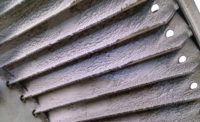When it comes to IAQ, contractors say there is no one-size-fits-all solution. There are many possible sources causing the pollution or irritation to the customer, and each situation can require a different approach to solve the problem. The good news is that it’s certainly possible to help customers improve their air quality and resulting health and comfort.
Customer Complaints
How do you know when you’re facing an IAQ issue? There are a few clues contractors can tap into based on their customers’ complaints.
Paul Sammataro, president of Samm’s Heating and Air Conditioning, Plano, Texas, knows there is a potential IAQ problem whenever he hears a customer say “I see mold,” or ask, “Why is there dirt around my vents?”
Similarly, Joe Strickler, president, Refrigeration & Electric Service Inc., Winter Haven, Fla., said a common complaint is that there is debris around the vents.
Beyond the visible evidence, customers also complain of symptoms that can indicate IAQ issues.
According to Fred Kobie, president of Kobie Kooling, Fort Myers, Fla., he pays attention when customers complain of allergy-like symptoms when inside the space.
Russ Donnici, president of Mechanical Air Service Inc., San Jose, Calif., added, “Generally, it’s respiratory complaints, sinus infections, headaches, and dry eyes.”
According to Martin Hoover, owner of Empire Heating and Air, Decatur, Ga., “Allergy, moisture, odor, and mold issues lead the charge.”
IAQ Troubleshooting
After you’ve heard the complaint, it’s time to investigate. And the best way to start is by listening to the customer.
According to Travis Smith, owner, Sky Heating and Air Conditioning, Portland, Ore., “We first find out what issues they are having, such as seasonal allergies, bad smells in their home, possible high VOC [volatile organic compounds] concentrations, or any medical issues that they feel may be attributed to their home, like dry skin and scratchy throats when they wake up in the morning.”
Eric Knaak, vice president of operations, Isaac Heating & Air Conditioning Inc., Rochester, N.Y., also believes that listening is key.
“For us, the approach has been individualized, depending on what the client is telling us,” he said.
Donnici said he starts with “a good interview of the client to see what the complaints or symptoms are.”
He continued, “We then tailor an approach based on that data to analyze what is taking place.”
To determine the source of an issue, Sammataro listed several areas to inspect: the indoor coil, blower, ducting, and filter/filtering system; the quality of the mastic seal/taping of the indoor system; the quality of the indoor system door gasket/door seal; if the supply and return boots are sealed to sheetrock properly; and unusual infiltration to the air delivery system.
At Mechanical Services Inc. of Central Florida, Orlando, Fla., Dennis Purvis, service manager, noted that his company is careful about notifying the client when technicians find a mold-like substance.
“Terminology is important. These guys are mechanical technicians and not trained environmentalists, so they cannot say unequivocally if it is a mold or mildew,” he explained. “We recommend that the client allow our indoor environment-certified technician to come out and examine the substance. We encourage building owners and managers not to ignore this and explain the possible litigation they could face by not responding. Upon completion of the inspection by our certified indoor environmentalist, a report is issued of the findings and the cost associated with the proper resolution.”
Donnici pointed out that there is not an all-inclusive test to determine inadequate IAQ in a home or building.
“Regarding IAQ issues, homes are much simpler to solve than commercial facilities,” he said. “Typically, it is more than one stressor that is causing the issue. Many times it’s also a perception there is an IAQ problem when, in reality, there isn’t. This can be the case in a commercial facility. It is not unusual for one or two people to complain about what they perceive as an IAQ issue and then create a concern by convincing others in the same area. This typically happens when management doesn’t acknowledge the complaint or start an investigation, such as requesting the individual or individuals keep a log with the date and time they feel symptomatic and what they are feeling.”
Kobie also noted that he has no prescribed order or list for determining IAQ problems. “Our belief is to eliminate as many potential sources as possible. Through elimination we can usually identify the source of a problem,” he said.
In his experience with HVAC and IAQ, Kobie said, “Filters are the main problem, and the main solution.”
He explained that education is needed about proper filtration — and that doesn’t necessarily mean expensive filtration.
“Too many people are using the wrong type of filter. Catching particulate is not complicated, and we have the technology to do it without hurting the machinery. Unfortunately, there are still uneducated salespeople pushing very dense media that is overfiltering air, creating both IAQ issues and premature mechanical breakdown,” Kobie said. “If a filter is fitted correctly and serviced appropriately to its needs, it eliminates over 90 percent of the maintenance issues and IAQ issues you could have. If you catch the particulate, it will not reach moisture to become an active microbial issue. The duct system will benefit from not having the particulate sent back through the ducts or to the house or space.”
Different Strokes for Different Folks
Once the issue has been identified, it’s time to offer solutions. And what solutions do contractors offer? Well, it all depends.
“There is no general solution,” said D. Brian Baker, president, Custom Vac Ltd., Winnipeg, Canada. “Each situation demands a different approach because some people are seriously ill while others have minor issues. We install HEPA air filtration, electronic air cleaners, HRVs [heat recovery ventilators], ERVs [energy recovery ventilators], source exhaust fans, new air conditioners, new furnaces, replace ductwork, install outdoor air intake vents, redesign and alter existing systems, refer them to an air sealing company or crawlspace remediation contractor, etc.”
Smith agreed, noting, “Different issues usually have different solutions.”
“For example, with allergies we recommend a minimum of a Honeywell F100 MERV 11 filter and give options for adding a Trane CleanEffects air purification system as well as an HRV system if the home is newer and they have sealed the home,” Smith said. “For customers who are building a new home, we recommend the Lifebreath ECM HRV systems, or for larger homes, the LifeBreath Dual Core HRV system to provide fresh air into the home and to remove the VOCs from the paints and materials used in construction. If customers have humidity issues, we offer the Honeywell TrueSteam line of products to add moisture to the air to help with dry skin and scratchy throats.”
According to David Dombrowski, manager, ARS/Rescue Rooter, Raleigh, N.C., “The best option to improve IAQ that we should address with all of our customers is not a product, but improvement of their air distribution systems. Unless all of the ductwork is in a clean, conditioned space, it is always in the best interest of the homeowner to have it properly sealed and/or replaced.”
Hoover, Sammataro, and Knaak also recommended duct renovation, replacement, and sealing as a common solution. Other typical solutions they offer to customers include UV lights, high-MERV filters, whole-home air cleaners, and HEPA filtration systems.
But Donnici reiterated, “It depends on the diagnosis of the problem. Some of the typical products we use are dual-bulb high-intensity UV light systems, which do an effective job of killing mold spores, bacteria, and viruses. … We also use high-efficiency air filtration products. However, the selection of high-efficiency air filtration is important since the application of the wrong product can also create a new problem.”
Proper application backed up by the right education will serve all contractors well as they navigate their customers’ IAQ complaints.
“It has been our experience that most contractors use IAQ as a marketing tool without the proper training or expertise, which often results in an inadequate result,” Donnici said. “It is unfortunate since there is a lot of training available if they would simply take the time to pursue it.”
Publication date: 7/15/2013
Want more HVAC industry news and information? Join The NEWS on Facebook, Twitter, and LinkedIn today!









